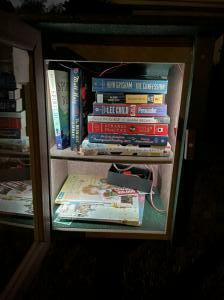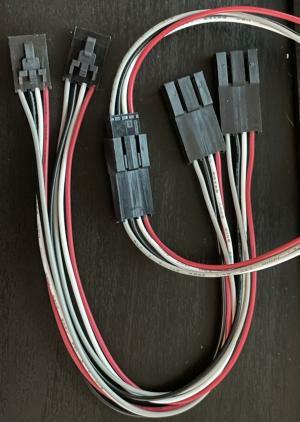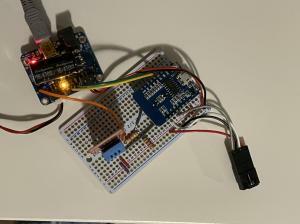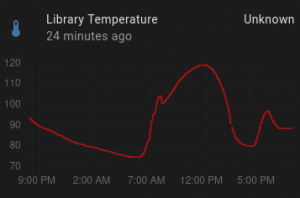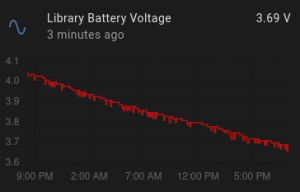Pete's Log: Solar library, part 2
Entry #1945, (Smokepacking)(posted when I was 42 years old.)
Made some more progress on the solar library, including an overnight test. Here's what it looks like lit up at night:
I'm pretty happy with it. I didn't take a picture of the light/door sensor jig I put together, but I did get better at soldering Neopixels. The light/sensor unit is composed of 4 sets of 5 Neopixels and the same reed sensor I'd been using. The Neopixels are arranged such that each shelf has 5 pixels on each side. It lights up pretty well. The door sensor seems to work well enough that I already glued the magnet to the door.
I had randomly decided to buy these connectors at Microcenter:
And I was clever enough to use them by cutting one in half and attaching one end to the lights/door sensor and the other end to my prototype board. So it made it easy to install the lights while being able to add/remove the board as needed while testing.
I also realized that to monitor the battery voltage, I would need a voltage divider and there just wasn't room for that on the prototype board I was using. So I moved the project to a perma-proto board which now looks much neater.
I briefly looked into migrating to an ESP32 instead of the ESP8266. The ESP8266 only has one analog input pin. I'd like to monitor both the battery voltage and the input voltage from the solar panel. A couple of my Hackerboxes had ESP32s, but I want to use them in the projects those boxes came with. Hackerbox 62 included an ESP32-S2, which seems promising since it looks to have lower power use than the ESP32. But I couldn't get it working with ESPHome, so I'm sticking with the ESP8266 for now. I'll settle for just knowing the battery voltage for now. My charger board does have signals for "charging" and "done charging" so at least that gives me a little insight on how the solar panel is doing.
The overnight test went well. I did not have the solar panel connected, I just wanted to see how it performed on a full battery.
The temperature in the library is going to be a concern. The battery specs say it's fine to discharge in up to 140 F temperature, but the max charging temperature is 113 F. So I may want to see if I can get the temp down a little. It seems to max out at 120 F so far, but that's still a bit warm. Can you see when a thunderstorm rolled through and brought the temperature down?
The little charging board does support adding a thermistor so it can disable charging the battery when it gets too warm. So I'll probably get one of those.
The voltage dropped from 4.2 to 3.6 over the course of about 26 hours. Which is about half its capacity. So that's not bad. The door was opened several times during the test, which turns the lights on. And notifies us. Jamie made fun of me for running to the front of the house each time to see if someone was actually there.
Anyway, more to do, but I'm happy with this project so far.
